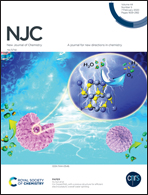An insight into regioselectivity in the transformation through a ruthenacycle†
Abstract
Ru(0)-catalysed cross-dimerisation of unsymmetrically substituted internal alkynes with conjugated dienes yields two conjugated triene products depending on the regioselectivity of the C–C bond formation reaction via a ruthenacycle intermediate. The electronic and steric effects of alkynes are comprehensively evaluated based on Hammett's (σp) and Taft's (σ*, Es) substituent constants. An electron-withdrawing substituent favours the external position of the conjugated triene products. With unsymmetrically 4,4′-disubstitued diaryl acetylenes, the logarithm plot for the regioisomer ratios of the products and differential Hammet's value Δσp between the substituents shows a linear relationship with a positive slope. This trend suggests that the electron-rich α-carbon in a ruthenacycle favours an electron-withdrawing group. This system is less sensitive to steric effects on the regioselectivity, but the sterically less bulky groups tend to prefer the external position.



 Please wait while we load your content...
Please wait while we load your content...